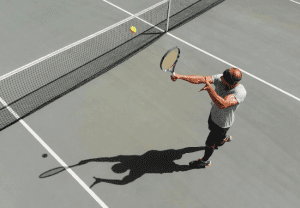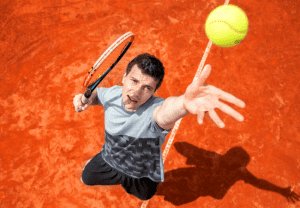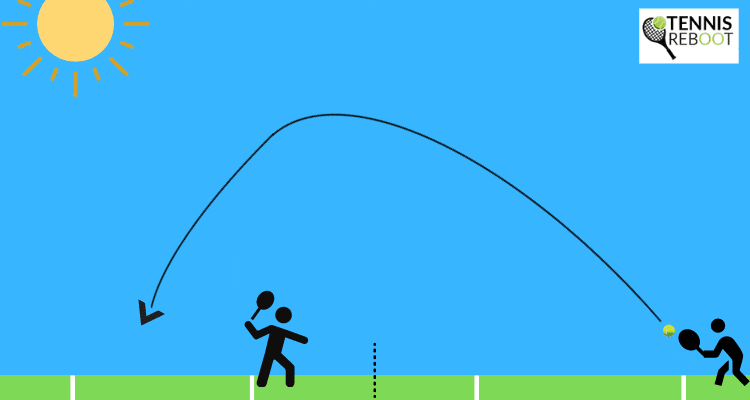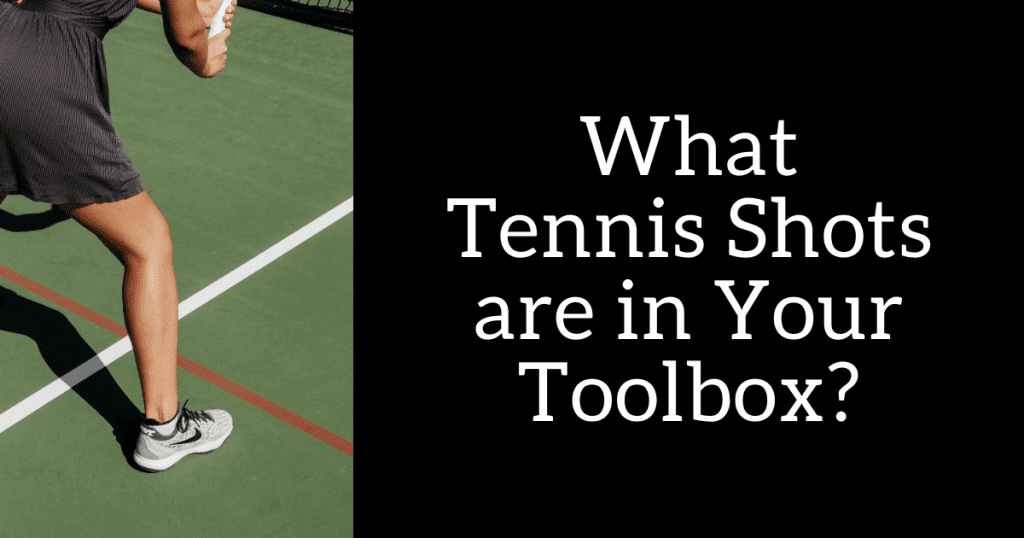To the average observer, tennis might look like two people smacking a ball back and forth across a net at one another.
Newsflash: that’s not far off. Well, tennis IS a complex sport with a number of different shots to be learned. But at the heart of it all, two people are smacking a ball back and forth across the net from each other!
The pros make tennis look easy but for those of us in the know, we know it is not. Tennis takes hard work and talent to master. We’re going to take a look at the many types of tennis shots.
Contents
Exploring Different Types of Tennis Shots
Understanding the types of tennis shots can be useful either as a player or as an avid watcher of the sport.
It makes watching tennis all the more interesting when you have a better understanding of what’s going on.
As a player, you need to know all the different shot types to know when it’s time to throw in a lob or to just drill a cross-court forehand. If you don’t know what a lob is, you won’t know how to hit one.
Having an understanding of the shots on paper will help you maximize your court time and better figure out the area where you need to work on your skills.
Before you hit the courts and play with other people (for the first time or at the beginning of each season), it’s not a bad idea to study and practice your tennis strokes.
Groundstrokes
When it comes to learning tennis, groundstrokes tend to be what are learned first.
Groundstrokes are the cornerstone of tennis. Having fundamental knowledge and ability hitting them will make tennis so much more enjoyable for you.
Both forehands and backhands are usually hit on or near the baseline.
Tennis Groundstroke: Forehand
The first thing you’ll learn in a tennis lesson is a forehand.
This key stroke is hit with the player’s dominant hand on their dominant side. A right-handed player turns to their right, takes their racket back and makes contact with the ball after swinging forward toward the net.
Generally, the most basic forehand and backhand strokes are flat (no spin) or have topspin (forward spin).
Tennis Groundstroke: Backhand
The backhand is a little more daunting for most beginner players and even some seasoned players! Rather than hitting naturally – like you’d swing a bat – you take your racket across the body and make contact with the ball seemingly on the back side of the racket.
A right-handed player turns to their left, takes the racket back across their body and swings forward toward the net. A backhand can be hit with one hand or both hands.
Like a forehand, many backhands are hit either flat or with topspin.
Slice Forehands and Backhands
Slice is defined as a shot hit with underspin.
The slice is often utilized when a player is on the defense, but not always. Steffi Graf used a slice backhand as her primary backhand 90+% of the time she was on court. Roger Federer hits slice backhands to change up the timing of his shots and to keep the ball low.
There’s a place in tennis for slice shots and it isn’t always when a player is on the defense.
This type of shot is about imparting underspin on the ball. The racket action sets the ball into a backspin.
Slice shots can be very effective in changing the pacing of a game and are often used when a player has very little time to react.
Volleys and Half Volleys

Ah, volleys. You know this one. It’s the shot that a player hits at the net without letting the ball bounce.
Depending on who you ask, volleys are both dreaded and loved in the tennis community. There’s more to hitting a volley than just not letting the ball hit the ground.
Volleys can be hit either on your forehand or backhand side and their primary purpose is for the player to hit from the net almost acting as a goalie – to not allow the ball to pass them into the back court.
A simple description of a valley is to block the ball back into your opponent’s court (usually out of their reach). But since nothing in tennis is simple, neither are volleys. It takes practice to be used to standing ground at the net and defending your position.
Then there’s the half volley which is a little more complicated.
Why? Because if you find yourself needing to hit a half volley, it generally means your out of position somewhat. You didn’t have time to get to the net to hit a full volley, but you also can’t set up for a full groundstroke because you’re too close to the net.
This is where the half volley saves the day. In such a situation, the player’s goal is simply to let the ball bounce and then immediately deflect it back over the net.
The timing of hitting a half volley can be quite tricky. You’re slightly out of position, the ball is low and it just bounced before you make contact – there’s a lot going on.
Serves

Every game of tennis starts with a serve. It can be an overhead serve or an underhand serve. The choice is yours.
A well-executed serve can be lighting fast and put your player in a defensive position from the get-go.
If you just want to show off a bit, mastering your serve can be an absolute game-changer.
Also, in case you haven’t noticed a pattern by now with other tennis shots, there are also multiple ways in which you can serve. There are many nuances between different serving techniques.
The below definitions barely scratch the surface of the different serving types. But since you have to start somewhere, here are the very basics of flat, kick and slice serves.
Flat Serve
Just like with the flat forehand or backhand, a flat serve is one with little to no spin.
They’re very powerful and difficult to return as they tend to be a faster, heavier ball coming at you.
When the ball bounces in your court as the returner, the shot bounces and continues forward in the same direction – quickly.
Though professionals can often use a single service toss to hit all variations of serve, those of us not on the pro circuit often use different tosses to achieve different serve results and placement.
As the server the toss for a flat serve is often more in front of your body. It sometimes feels like you’re chasing the ball to hit the serve. Based on it being out in front, virtually no spin is imparted when you make contact.
Flat serves down the T often result in aces for those who have great placement and speed.
Kick Serve
A kick serve is one where the server generates a lot of topspin. The server brushes up the back of the ball and creates forward spin and momentum.
If using the face of a digital clock, the server would try to hit straight up on the ball – from 6 to 12.
When the ball hits the ground, the forward spin ‘kicks’ the ball up much higher than a flat serve. The ball is often outside of the returners comfort zone making it a difficult serve to return.
This is also a serve that’s popular as a second serve because of the high likelihood of it landing within bounds.
It also takes more force to generate the spin so you sometimes have to hit it harder than you’d imagine.
On a second serve, this can come in handy because it forces you to really hit it and not just dink the ball over the net.
Slice Serve
Rather than brushing up the back of the ball at contact, a slice serve it hit by hitting the outer edge of the ball during the serve. When hitting a slice serve, a lot of spin is produced that causes havoc upon bouncing.
Unlike a flat serve that continues in the same direction after the ball bounces, a slice serve will bounce and then angle away which can make the serve tricky to return.
If using the clock face analogy again, the server would make contact with the ball at 1 or 2.
The changing of where contact is made drastically changes the spin applied to the ball and thus what happens after the ball bounces.
Specialty Tennis Shot Situations
The remaining shots are enhancements of the other shots already discussed.
Specialty shot situations can be hard to get the hang of but having so many more tools in your tennis toolbox will pay off.
Grab a big bucket of tennis balls and hit the courts as you’re going to want to practice these shots.
Lob
A lob is basically just a forehand or backhand shot that sails well over the other player’s head.

Lobs are a great defensive shot or are also ideal as a return when an opponent has run up to the net.
Check out our post to learn all about how to hit a lob.
Overhead Smash
The overhead is largely the same motion of your serve, but you didn’t toss the ball up and you’re usually well within the court when you make contact with the ball.
This is the shot used to punish someone for having hit a poor lob. They can be tricky to hit when the ball is very high or if you wait to hit it after the ball bounces.
If it well, the overhead can be a satisfying way to end a point.
Drop Shot
The drop shot involves the art of dropping the ball just barely on your opponent’s side of the net.
They’re a touch shot and require a whole lot of practice to get the hang of. They’re basically a slice shot on steroids – extreme backspin is applied with causes the ball to bounce very low or even bounce and come back toward the hitter – away from your opponent.
The art of this shot causes the other player to have to sprint up to the net in order to return the ball. Often, they barely make it there or if they do, the ball bounces a second time and the point is over.
If they do make it, they’re likely going to hit ‘up’ on the ball and you can be there to hit a groundstroke right by them or deploy the lob you’ve mastered.
Chip and Charge
If you want to put some serious pressure on your opponent when returning, try out the chip and charge.
This is where the player returns serve and immediately moves towards the net in preparation for a volley. The return of serve is often a slice shot so that it stays low and doesn’t bounce much.
Shots hit low are often returned high over the net. This is perfect if you’re at the net ready to hit the volley!
Wrapping Up
With so many tennis shots at our disposal, tennis requires a lot of practice and skill to be really good.
Many people who enjoy the sport of tennis don’t know how many different types of tennis shots there actually are.
As you improve, it becomes easier to know when to use what type of shot. As with most things, the only way to get better is to practice.
We all know practice makes perfect. Make sure you try a new shot the next time you’re on court.
One new shot just might become your new secret weapon as the score keeps going your way!

